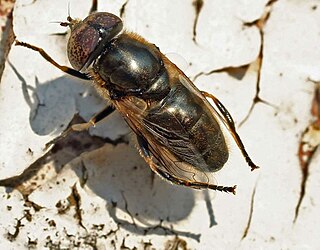
Helophilus trivittatus is a species of Palearctic hoverfly.

Helophilus hybridus is a hoverfly. It is a Palearctic species.

Leucozona glaucia, the Pale-saddled Leucozona is a Palearctic hoverfly. Larvae feed on ground layer aphids. Adults are usually seen visiting flowers.

Eristalinus sepulchralis is a European species of hoverfly. The species are brownish-white from a close up, and look like a wasp. From a distance though, they are yellowish-black coloured, and look like a bumble bee. The species can be found throughout Europe in the Baltic states, North Europe, Central, Southern and Western Europe and across the Palaearctic to Kamchatka, Japan, China and India. Finland, Great Britain, Hungary, Ireland, Norway, and the Netherlands.

Eupeodes latifasciatus is a species of hoverfly. Adults feed on nectar; larvae feed on aphids and scale insects.

Epistrophe eligans is a European species of hoverfly.

Leucozona laternaria is a European species of hoverfly.

Orthonevra nobilis is a species of hoverfly.

Eristalis abusiva is a European species of hoverfly. It is similar to Eristalis arbustorum.

Anasimyia contracta is a European species of hoverfly.

Anasimyia lineata is a Palaearctic species of hoverfly.
Anasimyia transfuga is a Palearctic species of hoverfly.

Parhelophilus consimilis is a Palearctic hoverfly.
Platycheirus amplus is a Holarctic species of hoverfly found in wetlands, fens, moorland streams and bogs.

Melangyna quadrimaculata is a European species of hoverfly.

Dasysyrphus pinastri is a species of hoverfly found in Europe.

Didea alneti is a Holarctic species of hoverfly.

Orthonevra geniculata is a species of hoverfly found in the Palearctic.

Brachypalpoides lentus is a European species of hoverflies.
Chrysotoxum fasciatum is a species of Holarctic hoverfly.


















